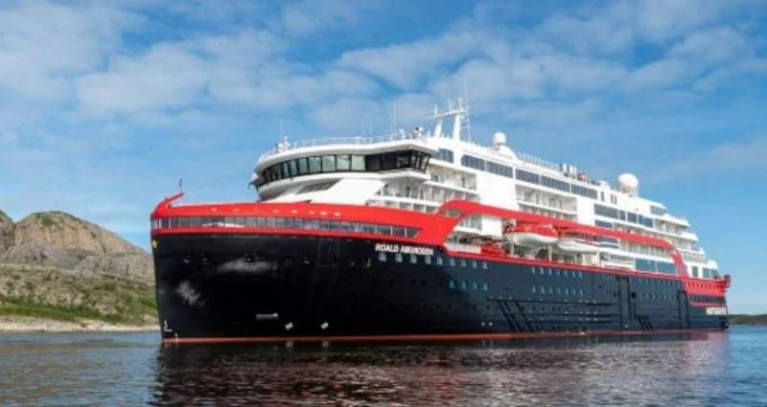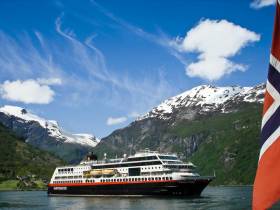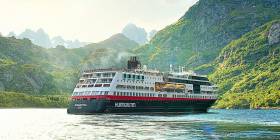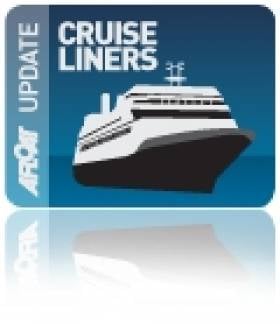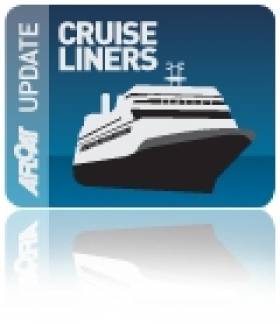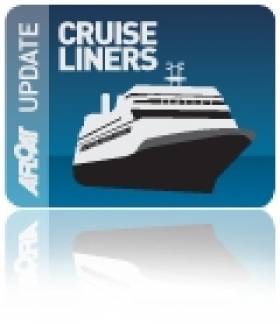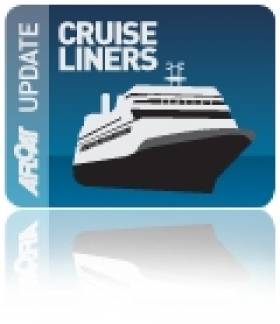Displaying items by tag: Hurtigruten
Crew Test Positive for Virus on Norwegian Cruiseship (Second Sister Having Called to Belfast in March)
Crew members, reports RTE News, numbering at least 36 have been confined on a Norwegian cruise ship to have tested positive for coronavirus, the company Hurtigruten said on Saturday.
Arriving at the northern Norwegian port of Tromso from the archipelago of Svalbard, the crew of the MS Roald Amundsen was quarantined on board the ship yesterday after four staff members tested positive for the virus and were hospitalised.
Of the 158 crew members on board, 36 are infected, Pal Jakobsen, media officer for the city of Tromso, told AFP, confirming a development that raises fears of a resurgence of cases in Norway.
The ship's company Hurtigruten had earlier indicated 33 positive tests. The infected crew were all Filipino apart from three people from France, Norway and Germany.
The company said yesterday that four crew members "were isolated several days ago because of other disease symptoms, with no symptoms of Covid-19".
"There was no reason to suspect Covid-19 when the ship docked in Tromso based on the symptoms they were showing," Hurtigruten said. For more click here.
Afloat.ie adds MS Roald Amundsen, leadship of a pair of the world's first hybrid-powered ships (see: second ship as Belfast Harbour's only caller) was originally scheduled to visit Waterford early next month. The 6-day 'British Isles-Enchanting Islands & Coastal Towns' cruise however will not include the call of the 2019 built cruiseship to the south-east Irish port.
The cancelled call to Ireland's oldest city, follows the Government's Covid-19 transport measures which among travel restrictions issued in late March and updated last month stipulated: All scheduled cruise ship travel has ceased. The National Health and Emergency Planning Team agreed that no cruise ship will be permitted to enter any Irish port or anchor in domestic waters.
As above the call to Belfast Harbour by the second hybrid-ship, MS Fridtjof Nansen in early March made a successful visit, though subsequently this year's newbuild did not involve a next port of call to Dublin Port.
Only one cruiseship Afloat adds has made visits to Irish ports this season, Saga Cruises veteran vessel Saga Sapphire which was on a farewell cruise for the UK operator when calling to Dublin Port on 11 March.
Two days later the former Hapag-Lloyd cruises custom-(1981) built Europa arrived to Cork Harbour where the ship's passengers were given a clean bill of health at Ringaskiddy.
#CruiseLiners - Limitation on speed in the Norwegian World Heritage fjords is one of several measures the Norwegian Maritime Authority (NMA) is considering in order to limit pollution from ships in these areas according to Cruise Europe.
DNV GL carried out a study on the authority’s behalf to assess the effect of a speed reduction, what that speed should be and to quantify the resulting anticipated reduction in emissions.
A study of all cruise and Hurtigruten ships operating in the area between January 2016 to October 2017 resulted in the findings that using a maximum speed of 12, 10 or 8 knots would mean a reduction in total maritime emissions of 10%, 15% and 19% respectively for Geirangerfjord and in the range of 6%, 8% and 10% for Naeroyfjord. The latter lower levels are due to vessels generally maintaining a lower speed here anyway. In the summary it states that “for the collective fleet 8 knots could be an ideal lower speed limit in order to reduce emissions”.
The NMA has now given a recommendation to the Climate and Environment Ministry. Bjorn E Pedersen, head of department legislation and international relations NMA, commented: “We based our recommendation on the DNV GL report. Basically we recommend a maximum speed for ships over 25,000gt in parts of the fjords varying from eight to 12 knots .”
He pointed out that the NMA jurisdiction does not include speed regulations, hence the Coastal Administration will be the authority making the final decision.
Although he thinks it is unlikely that it will come into force this year, he does not believe it will have too great a negative impact. “Our own analysis concludes that the time lost due to a maximum speed of 10 knots will have minimum consequence on the ship schedules.” He added that in meetings with the cruiselines, no concern has been expressed with regard to the proposed speed limitation.
#CorkCityCallers – An expedition / coastal cruiseship that trades to both polar regions and a megayacht cruiseship called to Cork City quays this morning, writes Jehan Ashmore.
Norwegian operator Hurtigruten Voyages Midnatsol (midnight sun) which normally plies stunning deep-inland fjords headed up the River Lee to the city’s South Quay. The call to the city-centre is also where Le Soléal, a megayacht from Ponant Cruises docked at North Custom Quay. The 10,000 tonnes cruiseship flagged in the French territory of Wallis and Fortuna Islands, has 132 passenger suites.
It is relatively unusual to have such small cruiseships together in the city-centre, and both having sailed overnight from the same previous port of call. Afloat yesterday monitored the cruiseships at anchorage off Hugh Town, St. Mary’s of the Isles of Scilly.
What is the norm given increasingly larger giant cruiseships that call downriver to Cobh’s deepwater quay. An example been Royal Caribbean International 90,000 tonnes Serenade of the Seas which is arriving this morning from Ponta Delgada, Azores.
Midnatsol’s call to Cork is in advance of resuming the classic Hurtigruten coastal voyages along Norway’s rugged and spectacular coast. The voyage that dates to 1893, involves calling to 34 ports that depart Bergen daily in the south and reach as far north to Kirkenes close to border with Russia.
Prior to sailing to Scilly, Midnatsol had called to Brest, France and before that La Coruña, Spain. This particular cruiseship is part of Hurtigruten’s global ‘Explorer’ voyages that run outside the domestic duties along Norway, however she will rejoin fleetmates from May to September. Since last year, Midnatsol began running expedition cruises to Patagonia and Antarctica.
Of the 12-strong Hurtigruten fleet of passenger, freight and car-carrying vessels, Midnatsol (in which can handle 35 cars), belongs to the largest class of ships, the ‘Millennium’ series. The 16,000 gross tonnage Midnatsol completed in 2003 was built in the Nordic country in Rissa and likewise of her sisters can carry 1,000 passengers.
The sisters are Finnmarken and Trollfjord, the latter made a special promotional port of call to Dun Laoghaire Harbour. This took place early in the career of the ship that berthed at the East Pier from where a visit was made on board the vessel painted in the operator’s distinctive livery of red, black and white.
Hurtigruten to Modify Explorer Ships for Shore Power
#ShorePower - Hurtigruten has announced plans to modify several of its vessels for shore power during first half of 2016.
The initiative follows a stronger environmental focus in the Norwegian company, which operates a fleet of 13 explorer vessels among them the new MS Spitsbergen. The shore power installation will significantly reduce fuel consumption and air pollution during port calls.
The company has signed an agreement of intent with the port of Bergen for development of the land-based shore power equipment – and is encouraging other ports to follow.
Initially, three vessels operating the Norwegian coast are being modified to connect to shore power installations during port calls. The first ship to be prepared for shore power is MS Kong Harald, which is currently being refurbished at Norway’s Fosen Yard.
Throughout the first half of 2016, another two vessels will have shore power installed, with the ambition to modify three more ships.
“To succeed with the green shift at sea, maritime stakeholders must commit to the objective, and cooperate. Cruise lines, ports, tech industry and politicians must pull in the same direction. A combination of incentives and regulations must guide the development of a greener industry. Shore power should be equally available in ports as the fenders are. We hope our initiative is met by quick actions in other Norwegian ports in addition to Bergen”, says Hurtigruten CEO Daniel Skjeldam.
Hurtigruten is continuously striving to reduce fuel consumption and greenhouse gas emissions from its operations. In addition to the shore power initiative, several other measures have been implemented the last years.
Shore power in Bergen, where the Hurtigruten ships are at berth for 8 hours daily during winter and 5, 5 hours during summer, will reduce CO2 emissions annually by almost 130 tons per ship. An annual reduction of NOx is estimated to approximately 2.5 tons.
Quartet of Hurtigruten Coastal Ships to Get New ‘Arctic Interior’ Makeover
#Hurtigruten – Norwegian operator, Hurtigruten has announced a refurbishment programme that will see four of its coastal ships under-going a total ‘Arctic Interior’ makeover in 2016.
The company is already undertaking a total refurbishment of the newly acquired MS Spitsbergen as previously reported on Afloat.ie is a former ferry built for the Azores but never went into service.
Also announced are plans to operate MS Spitbergen as an additional ship on the Norwegian coastal route next summer, before she officially takes the place of MS Midnatsol in autumn 2016.
“We are a first mover company and we are now reinventing the Hurtigruten experience. By combining tradition, innovation and sustainability, we aim to ensure the position as world leader in nature-based explorer travels in polar waters”, says Hurtigruten CEO Daniel Skjeldam.
MS Polarlys will be the first ship to be refurbished in January 2016, during a 22 day programme of round the clock works. Upgrading of MS Kong Harald, MS Nordkapp and MS Nordnorge will follow.
The ships will be fitted with a modern Scandinavian interior, reflecting the coastal landscapes of the Arctic.
“The interior will reflect the breath-taking coastal landscapes we sail past. We have made it stylish and yet unpretentious. The colours are earthy and from the coast and the sea. Many of the materials are natural, such as wood, slate and leather” says Magnus Zetterberg, Managing Director of Hurtigruten UK.
All common areas of the ships will see changes with the reception areas, cafes, bistro areas and the aft deck all to be renovated.
One of the highlights of any Coastal voyage with Hurtigruten is the local Norwegian cuisine served in the restaurant, with menus changing every day to reflect the specialities of the area the ship is sailing through.
The new, stylish restaurants with a modern Nordic feel, will provide an ideal setting for the menus. A range of fresh pastries baked on board will be served and a new feature will be barbecue stands out on deck.
Facilities on MS Spitsbergen will be similar to those already offered across the fleet and she will offer suites with a private balcony and full length windows - offering passengers their own private space from which to watch the northern lights or midnight sun.
Hurtigruten Appoint New Country Director UK & Ireland
#Hurtigruten – Hurtigruten, operators of a fleet of 12 ships on the Norwegian coastal voyages have appointment Cecilia Abert as Country Director for the UK & Ireland with her position to take place in mid-February.
"Cecilia comes with a wealth of experience that will enable us to substantially grow our business in this key strategic market place" commented Hurtigruten's Chief Commercial Officer, Magnus Wrahme.
In her capacity as Country Director, Ms. Abert will oversee the sales, marketing and brand building of the Hurtigruten product offering the Norwegian Coastal Voyages, the expedition voyages to Antarctica, Greenland and Arctic's Svalbard, as well as land-based polar adventures. They also operate in European waters in the spring and autumn.
"I am so excited to take the Hurtigruten brand to the next level and continue to build increased awareness for this highly differentiated business with its unique 122 year history. I believe there are tremendous opportunities within the growing exploration travel and cruise markets to offer products which consumers are asking for. Whether nature lovers or adventure seekers, Hurtigruten offers something for everyone", stated Abert.
Cecilia brings an extensive track record in travel sales and marketing to her new role at Hurtigruten. Prior to joining the team, she spent over 11 years with Regent Seven Seas Cruises (formerly Radisson). Most recently, she was Senior Sales & Marketing Director overseeing all commercial initiatives in UK & Europe.
Contrasting Cruiseship Callers Due Double Docking
#CruiseLiners – For the first time during the 2013 Dublin Port cruise season, two such vessels are due to dock on the same day and only hours apart, writes Jehan Ashmore.
The French mega-yacht style cruiseship Le Boreal from Caen, Normandy is scheduled to arrive first in the early hours of next Sunday. She will be followed by the Norwegian polar region cruise expedition vessel Fram with an arrival from Cork.
Sleek lined Le Boreal is operated by Compagnie due Ponant yacht cruises and the stoutly proportioned Fram is run by Hurtigruten. This operator of course is famous for providing the important Norwegian coastal voyage between Bergen and Kirkenes, beyond the Arctic circle and bordering the Russian Federation.
Among the many regions, the Fram explores the other end of the world with cruises in the Antarctic Ocean.
Dublin Port can look forward to another record breaking year with around 105 cruise calls scheduled in 2013, this compares to last year where there were 89 arrivals. The rise in the 2013 season reflects approximately an increase of 20% compared to last year.
Fram From the Fjords and Beyond
Fram operates on cruises from Norway to Spitsbergen, Greenland, and Europe. She also cruises in Antarctic waters and explores the Chilean fjords. She can handle 400 passengers in 254 berths. On board there is a reception area, a large top-deck glass-enclosed observation salon positioned forward, bar, restaurant, library, shop and leisure facilities, including gym, sauna and jacuzzi. For further information and deck plans click HERE.
Throughout her interior she has traditional and modern artwork from a selection of Norwegian and Greenlandic artists. To read more on her Antarctic cruises and other destinations click HERE.
On this particular cruise, she had departed from Bergin and called to several Scottish ports prior to berthing in Belfast and docking in Dublin yesterday. This evening she heads for the Isles of Scilly, followed by a call to Portsmouth before disembarking her passengers in Hamburg.
Cruise-Talk at the Holiday World Show
The following ferry and cruise operators are exhibiting at the show: Azamara Cruises, Celebrity Cruises, Celtic Link Ferries, Cruise & Maritime Voyages, Cruise Holidays, Travel.ie, Hurtigruten, John Galligan Travel, MSC Cruises, Princess Cruise Lines, Pullmantur Cruises, Regent Seven Seas Cruises, Royal Caribbean Cruise Line, Saga, Silversea Cruises, Thomas Cook and Voyages To Antiquity.
Also exhibiting is Emerald Star for those interested in taking a cabin-cruiser holiday on the Shannon.
For opening times of Holiday World Show (incorporating the Caravan & Motor Home Show) see below
Friday 28 January 1.00 pm - 8.00 pm
Saturday 29 January 11.00 am - 5.30 pm
Sunday 30 January 11.00 am - 5.30 pm
For a full listing of exhibitors, ticket prices and further information about the show logon to www.holidayworldshow.com


























